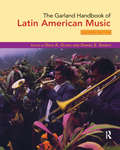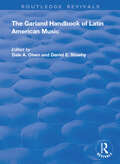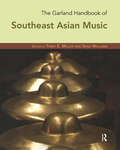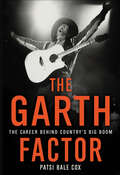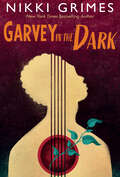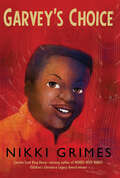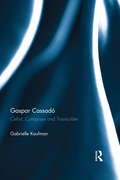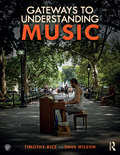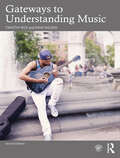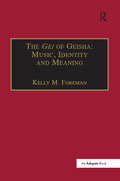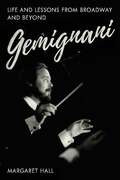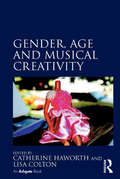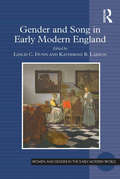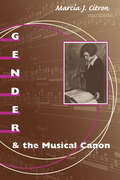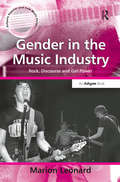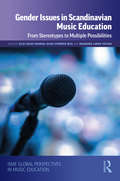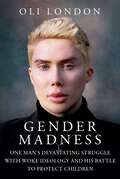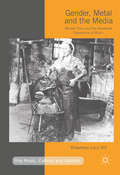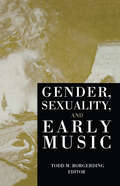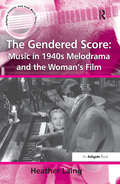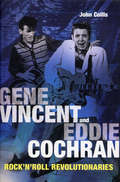- Table View
- List View
The Garland Handbook of Latin American Music (Reference Library Of The Humanities)
by Dale A. Olsen and Daniel E. SheehyThe Garland Handbook of Latin American Music is comprised of essays from The Garland Encyclopedia of World Music: Volume 2, South America, Mexico, Central America, and the Carribean, (1998). Revised and updated, the essays offer detailed, regional studies of the different musical cultures of Latin America and examine the ways in which music helps to define the identity of this particular area. Part One provides an in-depth introduction to the area of Latin America and describes the history, geography, demography, and cultural settings of the regions that comprise Latin America. It also explores the many ways to research Latin American music, including archaeology, iconography, mythology, history, ethnography, and practice. Part Two focuses on issues and processes, such as history, politics, geography, and immigration, which are responsible for the similarities and the differences of each region’s uniqueness and individuality. Part Three focuses on the different regions, countries, and cultures of Caribbean Latin America, Middle Latin America, and South America with selected regional case studies. The second edition has been expanded to cover Haiti, Panama, several more Amerindian musical cultures, and Afro-Peru. Questions for Critical Thinking at the end of each major section guide focus attention on what musical and cultural issues arise when one studies the music of Latin America -- issues that might not occur in the study of other musics of the world. Two audio compact discs offer musical examples of some of the music of Latin America.
The Garland Handbook of Latin American Music
by Dale A. Olsen; Daniel E. SheehyFirst Published in 2000. The Garland Handbook of Latin American Music is comprised of essays from The Garland Encyclopedia of World Music: Volume 2, South America, Mexico, Central America, and the Carribean, (1998). Revised and updated, the essays offer detailed, regional studies of the different musical cultures of Latin America and examine the ways in which music helps to define the identity of this particular area. Part One provides an in-depth introduction to the area of Latin America and describes the history, geography, demography, and cultural settings of the regions that comprise Latin America. It also explores the many ways to research Latin American music, including archaeology, iconography, mythology, history, ethnography, and practice. Part Two focuses on issues and processes, such as history, politics, geography, and immigration, which are responsible for the similarities and the differences of each region's uniqueness and individuality. Part Three focuses on the different regions, countries, and cultures of Caribbean Latin America, Middle Latin America, and South America with selected regional case studies. The second edition has been expanded to cover Haiti, Panama, several more Amerindian musical cultures, and Afro-Peru. Questions for Critical Thinking at the end of each major section guide focus attention on what musical and cultural issues arise when one studies the music of Latin America -- issues that might not occur in the study of other musics of the world. Two audio compact discs offer musical examples of some of the music of Latin America.
The Garland Handbook of Southeast Asian Music
by Terry E. Miller Sean WilliamsThe Garland Handbook of Southeast Asian Music is comprised of essays from The Garland Encyclopedia of World Music: Volume 4, Southeast Asia (1998). Largely revised and updated, the essays offer detailed, regional studies of the different musical cultures of Southeast Asia and examine the ways in which music helps to define the identity of this particular area. Part one provides an in-depth introduction to the area of Southeast Asia and explores a series of issues and processes, such as colonialism, mass media, spirituality, and war. The articles in this section are important in gaining historical, political, and social perspective. Part two focuses on mainland Southeast Asia, with essays representing Cambodia, Thailand, Laos, Burma, Peninsular Malaysia, Vietnam, Singapore, and the minority peoples of mainland Southeast Asia. Part three focuses on island Southeast Asia, dividing the area into three sections: Indonesia, the Philippines, and Borneo. In addition to offering a detailed study of the music of each area, it also offers recent perspectives on the gamelan and theater traditions of Indonesia. Questions for Critical Thinking at the end of each major section guide and focus attention on what issues – musical and cultural – arise when one studies the music of Southeast Asia – issues that might not occur in the study of other musics of the world. An accompanying compact disc offers musical examples from Southeast Asia.
Garth Brooks: Straight from the Heart
by Edward TallmanA short biography of country music/pop singer Garth Brooks which includes some family background, the singer's school days, marriage, musical career, choice of and feelings about music and awards. It concludes shortly after the birth of his first daughter, Taylor in 1992. Contains a discography, index, all picture captions and descriptions of most pictures
The Garth Factor: The Career Behind Country's Big Boom
by Patsi Bale CoxGarth Brooks is certified by the RIAA as the #1 selling solo artist in US history. Since his debut in 1990, he has sold over 128 million albums. But success rarely comes without controversy, and Garth has had more than a share. Is he a media and market manipulator, a country music poseur, and a megalomaniac, or is he simply a brilliant businessman and marketing strategist? Industry insider Patsi Bale Cox, who generated all label material on Brooks throughout his career, examines the meteoric rise of the country star. Examining his career within the context of country music history, she takes readers behind closed doors at the labels, and delves into the inner sanctum of the Nashville music community. The Garth Factor will paint a portrait of how Brooks's friendship with Trisha Yearwood developed into love and marriage, explore the truth behind his "alter-ego" Chris Gaines, and update readers on what he has been up to since retirement.
Garth Pig Steals the Show
by Mary RaynerFrom the book: The Pig family has formed a band, but they need one more player. On the very day of their big concert, a hairy horn-blower sticks her long, pointed nose through the door and volunteers to play. William Pig wonders about this mysterious musician who spends most of the performance licking her lips. And when Garth suddenly disappears from his chair, it's up to William to save his little brother and the show. With some creative conducting, he brings the concert to an unforgettable finale. Performing with all the humor and affection of their previous adventures, Mary Rayner's beloved Pig family is sure to receive a hearty "Bravo!" for their latest triumph. Other books about the Pig family are available from Bookshare.
Garvey in the Dark
by Nikki Grimes"Garvey in the Dark is more than a beautifully crafted novel in verse. It&’s a story that faces news headlines and captures the wild emotional roller coaster of the COVID-19 pandemic with honesty and courage. A must-read for young people who lived through the early days of the outbreak as well as those who will be curious about it in years to come." —Kate Messner, New York Times bestselling author&“With deceptive simplicity, Grimes captures characters and emotions by wielding a poetic form—the tanka—with superb and superhuman strength, and the result is a beautiful and brilliant book about how faith, grace, and familial love can help us triumph over adversity...&” —Padma Venkatraman, Walter Award-winning author of The Bridge HomeCapturing the shock and impact of the COVID-19 pandemic through the eyes of Garvey, a beloved character, Nikki Grimes&’s newest novel in verse shows readers how to find hope in difficult times.Garvey&’s finally happy—he&’s feeling close to his father through their shared love of music, bullies are no longer tormenting him, and his best friends Manny and Joe are by his side. But when the schools, stores, and restaurants close because people are getting sick, Garvey&’s improved life goes into lockdown as well. And when Garvey&’s father gets sick, Garvey must find a way to use his newfound musical skills to bring hope to both his father and himself. Moving, powerful, and beautifully told, this remarkable novel shows readers how even small acts have large reverberations, how every person can make a difference in this world, and how—even in the most difficult times—there are ways to reach for hope and healing. Nikki Grimes is a New York Times bestselling author who has won the ALAN Award for outstanding contributions to young adult literature, the Children's Literature Legacy Award, the Virginia Hamilton Award for Lifetime Achievement, and NCTE Award for Excellence in Poetry for Children. She has also received several ALSC Notables, a Coretta Scott King Author Award, Coretta Scott King Author Honors, Boston Globe-Horn Book Honors, a Printz Honor, and a Sibert Honor.
Garvey's Choice
by Nikki GrimesGarvey's father has always wanted Garvey to be athletic, but Garvey is interested in astronomy, science fiction, reading--anything but sports. <P><P>Feeling like a failure, he comforts himself with food. Garvey is kind, funny, smart, a loyal friend, and he is also obese, teased by bullies, and lonely. <P><P>When his only friend encourages him to join the school chorus, Garvey's life changes. The chorus finds a new soloist in Garvey, and through chorus, Garvey finds a way to accept himself, and a way to finally reach his distant father--by speaking the language of music instead of the language of sports. <P>This emotionally resonant novel in verse by award-winning author Nikki Grimes celebrates choosing to be true to yourself.
Gaspar Cassadó: Cellist, Composer and Transcriber
by Gabrielle KaufmanBarcelonian Gaspar Cassadó (1897-1966) was one of the greatest cello virtuosi of the twentieth century and a notable composer and arranger, leaving a vast and heterogeneous legacy. In this book, Gabrielle Kaufman provides the first full-length scholarly work dedicated to Cassadó, containing the results of seven years of research into his life and legacy, after following the cellist’s steps through Spain, France, Italy and Japan. The study presents in-depth descriptions of the three main parts of Cassadó’s creative output: composition, transcription and performance, especially focusing on Cassadó’s plural and multi-facetted creativity, which is examined from both cultural and historical perspectives. Cassadó’s role within the evolution of twentieth-century cello performance is thoroughly examined, including a discussion regarding the musical and technical aspects of performing Cassadó’s works, aimed directly at performers. The study presents the first attempt at a comprehensive catalogue of Cassadó’s works, both original and transcribed, as well as his recordings, using a number of new archival sources and testimonies. In addition, the composer’s significance within Spanish twentieth-century music is treated in detail through a number of case studies, sustained by examples from recovered score manuscripts. Illuminated by extraordinary source material Gaspar Cassadó: Cellist, Composer and Transcriber expands and deepens our knowledge of this complex figure, and will be of crucial importance to students and scholars in the fields of Performance Practice and Spanish Music, as well as to professional cellists and advanced cello students.
Gateways to Understanding Music
by Timothy Rice Dave WilsonGateways to Understanding Music explores music in all the categories that constitute contemporary musical experience: European classical music, popular music, jazz, and world music. Covering the oldest forms of human music making to the newest, the chronological narrative considers music from a global rather than a Eurocentric perspective. Each of sixty modular "gateways" covers a particular genre, style, or period of music. Every gateway opens with a guided listening example that unlocks a world of music through careful study of its structural elements. Based on their listening experience, students are asked to consider how the piece came to be composed or performed, how the piece or performance responded to the social and cultural issues at the time and place of its creation, and what that music means today. Students learn to listen to, explain, understand, and ultimately value all the music they may encounter in their world. FEATURES Global scope—Presents all music as worthy of study, including classical, world, popular, and jazz. Historical narrative—Begins with small-scale forager societies up to the present, with a shifting focus from global to European to American influences. Modular framework—60 gateways in 14 chapters allow flexibility to organize chronologically or by the seven recurring themes: aesthetics, emotion, social life, links to culture, politics, economics, and technology. Listening-guided learning—Leads to understanding the emotion, meaning, significance, and history of music. Introduction of musical concepts—Defined as needed and compiled into a Glossary for reference. Consistent structure—With the same step-by-step format, students learn through repeated practice how to listen and how to think about music. In addition to streamed audio examples, the companion website hosts essential instructors’ resources.
Gateways to Understanding Music
by Dave Wilson Timothy RiceGateways to Understanding Music, Second Edition, explores music in all the categories that constitute contemporary musical experience: European classical, popular, jazz, and world music. Covering the oldest forms of human music making to the newest, this chronology presents music from a global rather than a Eurocentric perspective. Each of 60 "gateways" addresses a particular genre, style, or period of music. Every gateway opens with a guided listening example that unlocks a world of music through careful study of its structural elements. How did the piece come to be composed or performed? How did it respond to the social and cultural issues at the time, and what does that music mean today? Students learn to listen to, explain, understand, and ultimately value all the music they encounter in their world. New to this edition is a broader selection of musical examples that reflect the values of diversity, equity, and inclusion advocated by North American universities. Eight gateways have been replaced. A timeline of gateways helps students see the book’s historical narrative at a glance. Features Values orientation—Diverse, equitable, and inclusive approach to music history. All genres of music—Presents all music as worthy of study, including classical, world, popular, and jazz. Global scope within a historical narrative—Begins with small-scale forager societies up to the present, with a shifting focus from global to European to American influences. Recurring themes — Aesthetics, emotion, social life, links to culture, politics, economics, and technology. Modular framework—60 gateways—each with a listening example—allow flexibility to organize chronologically or by the seven themes. Consistent structure—With the same step-by-step format, students learn through repeated practice how to listen and how to think about music. Anthology of scores—For those courses that use the textbook in a music history sequence. Gateways to Understanding Music continues to employ a website to host the audio examples and instructor’s resources.
Geddy Lee's Big Beautiful Book of Bass
by Geddy LeeRock ‘n’ Roll Hall of Famer and Rush bassist Geddy Lee celebrates rock music’s thunderous, rumbly bottom end—the bass—in this unique, lavishly illustrated, full-color compendium showcasing over two hundred rare, iconic, beautiful, and sometimes eccentric bass guitars from his extensive collection. <P><P>In this luxurious keepsake volume, Geddy Lee chronicles the fascinating history of one of rock music’s foundation instruments, the bass guitar. Written with arts journalist Daniel Richler, gorgeously photographed by Richard Sibbals, and with insight from Geddy’s trusted bass tech and curator, John "Skully" McIntosh, Geddy Lee’s Big Beautiful Book of Bass profiles over two hundred classic basses from Geddy’s extensive collection. <P><P>The book combines knowledge and observations gleaned from Geddy’s long, successful career with new and behind-the-scenes photos, ranging from his earliest days to Rush’s sold-out 40th anniversary tour in 2015, plus personal interviews with some of the world’s top bassists and collectors. <P><P>A musician and guitar freak, Geddy has acquired the magnificent bass models that have been the backbone of the world’s greatest popular music, from greats such as Paul McCartney, John Entwistle, and Jack Bruce. <P><P>The book features vintage basses from 1950 through the mid-1970s—the golden age of guitar making. <P><P>Suffused with Geddy’s intelligence, taste, and disarming wit, Geddy Lee’s Big Beautiful Book of Bass is also an entertaining look at a legend’s career on stage, in the studio, and at home. Geddy shares his views of the role of the bass guitar in his life and in the lives of the great players who’ve influenced him, revealing his passions and motivations, and ultimately broadening fans’ appreciation of his beloved instrument.
The Gei of Geisha: Music, Identity and Meaning (Soas Studies In Music Ser.)
by KellyM. ForemanThe Japanese geisha is an international icon, known almost universally as a symbol of traditional Japan. Numerous books exist on the topic, yet this is the first to focus on the 'gei' of geisha - the art that constitutes their title (gei translates as fine art, sha refers to person). Kelly M. Foreman brings together ethnomusicological field research, including studying and performing the shamisen among geisha in Tokyo, with historical research. The book elaborates how musical art is an essential part of the identity of the Japanese geisha rather than a secondary feature, and locates current practice within a tradition of two and half centuries. The book opens by deconstructing the idea of 'geisha' as it functions in Western societies in order to understand why gei has been, and continues to be, neglected in geisha studies. Subsequent chapters detail the myriad musical genres and traditions with which geisha have been involved during their artistic history, as well as their position within the traditional arts society. Considering the current situation more closely, the final chapters explore actual dedication to art today by geisha, and analyse how they create impromptu performances at evening banquets. An important issue here is geisha-patron artistic collaboration, which leads to consideration of what Foreman argues to be the unique and essential nexus of identity, eroticism and aesthetics within the geisha world.
Gemignani: Life and Lessons From Broadway and Beyond
by Margaret HallPAUL GEMIGNANI is one of the titans of the modern musical theater industry. Serving as musical director for more than forty Broadway productions since 1971, his collaborations with Stephen Sondheim, Andrew Lloyd Webber, John Kander, Fred Ebb, Hal Prince, Michael Bennett, and Alan Menken have led to countless accolades for his collaborators, but due to the nearly invisible position of the musical director in the Broadway industry, Gemignani's story is often overlooked. GEMIGNANI: Life and Lessons from Broadway and Beyond seeks to not only bring the reader into the orchestra pit to learn Gemignani's story, but also to educate the reader about the crucial role a music director plays in bringing some of the most iconic musicals in Broadway history to life. Born into a second-generation Italian American family during the aftershocks of the Great Depression, Gemignani worked his way up from playing percussion in USO bands to conducting before Leonard Bernstein, all before becoming a pivotal player in the team that brought some of the most successful musicals of the late twentieth century to the stage. Sweeney Todd, Evita, Merrily We Roll Along, Sunday in the Park with George, and Into the Woods would be quite different without his key contributions, and many of the sonic markers we now associate with the postmodern musical theater can be traced to Gemignani's careful curiosity to expand the bounds of what was possible. MARGARET HALL is one of the foremost emerging theater historians of her generation. She received her bachelor of fine arts in drama from New York University, Tisch School of the Arts, and is currently in the process of obtaining her masters in musical theater history from New York University, Gallatin School of Individualized Study, the first degree of its kind to be granted worldwide. She works as a teacher of musical theater history and has students across the globe. She may be reached at www.margaret-hall.com.
Gender, Age and Musical Creativity
by Lisa Colton Catherine HaworthFrom the perennially young, precocious figure of 'little orphan Annie' to the physical and vocal ageing of the eighteenth-century castrato, interlinked cultural constructions of age and gender are central to the historical and contemporary depiction of creative activity and its audiences. Gender, Age and Musical Creativity takes an interdisciplinary approach to issues of identity and its representation, examining intersections of age and gender in relation to music and musicians across a wide range of periods, places, and genres, including female patronage in Renaissance Italy, the working-class brass band tradition of northern England, twentieth-century jazz and popular music cultures, and the contemporary 'New Music' scene. Drawing together the work of musicologists and practitioners, the collection offers new ways in which to conceptualise the complex links between age and gender in both individual and collective practice and their reception: essays explore juvenilia and 'late' style in composition and performance, the role of public and private institutions in fostering and sustaining creative activity throughout the course of musical careers, and the ways in which genres and scenes themselves age over time.
Gender and Song in Early Modern England (Women And Gender In The Early Modern World Ser.)
by Katherine R. Larson Leslie C. DunnSong offers a vital case study for examining the rich interplay of music, gender, and representation in the early modern period. This collection engages with the question of how gender informed song within particular textual, social, and spatial contexts in sixteenth- and seventeenth-century England. Bringing together ongoing work in musicology, literary studies, and film studies, it elaborates an interdisciplinary consideration of the embodied and gendered facets of song, and of song’s capacity to function as a powerful-and flexible-gendered signifier. The essays in this collection draw vivid attention to song as a situated textual and musical practice, and to the gendered processes and spaces of song's circulation and reception. In so doing, they interrogate the literary and cultural significance of song for early modern readers, performers, and audiences.
Gender and the Musical Canon
by Marcia J. CitronA classic in gender studies in music Marcia J. Citron's comprehensive, balanced work lays a broad foundation for the study of women composers and their music. Drawing on a diverse body of feminist and interdisciplinary theory, Citron shows how the western art canon is not intellectually pure but the result of a complex mixture of attitudes, practices, and interests that often go unacknowledged and unchallenged. Winner of the Pauline Alderman Prize from the International Alliance of Women in Music, Gender and the Musical Canon explores important elements of canon formation, such as notions of creativity, professionalism, and reception. Citron surveys the institutions of power, from performing organizations and the academy to critics and the publishing and recording industries, that affect what goes into the canon and what is kept out. She also documents the nurturing role played by women, including mothers, in cultivating female composers. In a new introduction, she assesses the book's reception by composers and critics, especially the reactions to her controversial reading of Cécile Chaminade's sonata for piano. A key volume in establishing how the concepts and assumptions that form the western art music canon affect female composers and their music, Gender and the Musical Canon also reveals how these dynamics underpin many of the major issues that affect musicology as a discipline.
Gender in the Music Industry: Rock, Discourse and Girl Power (Ashgate Popular And Folk Music Ser.)
by Marion LeonardWhy, despite the number of high profile female rock musicians, does rock continue to be understood as masculine? Why is rock generally assumed to be created and performed by men? Marion Leonard explores different representations of masculinity offered by, and performed through, rock music, and examines how female rock performers negotiate this gendering of rock as masculine. A major concern of the book is not specifically with men or with women performing rock, but with how notions of gender affect the everyday experiences of all rock musicians within the context of the music industry. Leonard addresses core issues relating to gender, rock and the music industry through a case study of 'female-centred' bands from the UK and US performing so called 'indie rock' from the 1990s to the present day. Using original interview material with both amateur and internationally renowned musicians, the book further addresses the fact that the voices of musicians have often been absent from music industry studies. Leonard's central aim is to progress from feminist scholarship that has documented and explored the experience of female musicians, to presenting an analytic discussion of gender and the music industry. In this way, the book engages directly with a number of under-researched areas: the impact of gender on the everyday life of performing musicians; gendered attitudes in music journalism, promotion and production; the responses and strategies developed by female performers; the feminist network riot grrrl and the succession of international festivals it inspired under the name of Ladyfest.
Gender Issues in Scandinavian Music Education: From Stereotypes to Multiple Possibilities (ISME Series in Music Education)
by Silje Valde OnsrudGender Issues in Scandinavian Music Education: From Stereotypes to Multiple Possibilities introduces much-needed updates to research and teaching philosophies that envision new ways of considering gender diversity in music education. This volume of essays by Scandinavian contributors looks beyond the dominant Anglo-American lens while confronting a universal need to resist and rethink the gender stereotypes that limit a young person’s musical development. Addressing issues at all levels of music education—from primary and secondary schools to conservatories and universities— topics discussed include: the intersection of social class, sexual orientation, and teachers’ beliefs; gender performance in the music classroom and its effects on genre and instrument choice; hierarchical inequalities reinforced by power and prestige structures; strategies to fulfill curricular aims for equality and justice that meet the diversity of the classroom; and much more! Representing a commitment to developing new practices in music education that subvert gender norms and challenge heteronormativity, Gender Issues in Scandinavian Music Education fills a growing need to broaden the scope of how gender and equality are situated in music education—in Scandinavia and beyond.
Gender Madness: One Man's Devastating Struggle with Woke Ideology and His Battle to Protect Children
by Oli LondonHow one man's struggles with self-Identity and detransition lays challenge to the very foundation of the "gender ideology" movement. While documenting his own personal identity struggles with gender and self-identity, British K-Pop singer Oli London explores the root cause of the issue of trans ideology and gender identity, tackling the pressures of social media, the education system, media, and other factors that are pushing a growing number of young people into transitioning. He takes a close look at real world examples and examines laws, research, and data to help lift the lid on the multibillion-dollar gender affirming care industry.Gender Madness gives an intimate look into what led Oli London to want to become a "Korean woman" and how he overcame his battle to become an advocate for the millions of young people who question their own identity. He recently publicly announced he had detransitioned and is living as a male again and has since become an outspoken activist for children and women's rights, appearing regularly on numerous news networks including Fox News, Newsmax, OAN, EWTN, Piers Morgan Uncensored, Tucker Carlson Tonight, and Talk TV to campaign against gender affirming surgery in teenagers. This book shares his deeply personal life journey and his important message to others, all while encouraging readers to question the current societal trends and challenge their own way of thinking.
Gender, Metal and the Media: Women Fans and the Gendered Experience of Music (Pop Music, Culture and Identity)
by Rosemary Lucy HillThis book is a timely examination of the tension between being a rock music fan and being a woman. From the media representation of women rock fans as groupies to the widely held belief that hard rock and metal is masculine music, being a music fan is an experience shaped by gender. <P><P>Through a lively discussion of the idealised imaginary community created in the media and interviews with women fans in the UK, Rosemary Lucy Hill grapples with the controversial topics of groupies, sexism and male dominance in metal. She challenges the claim that the genre is inherently masculine, arguing that musical pleasure is much more sophisticated than simplistic enjoyments of aggression, violence and virtuosity. <P>Listening to women’s experiences, she maintains, enables new thinking about hard rock and metal music, and about what it is like to be a women fan in a sexist environment.
Gender, Metal and the Media: Women Fans and the Gendered Experience of Music (Pop Music, Culture and Identity)
by Rosemary Lucy HillThis book is a timely examination of the tension between being a rock music fan and being a woman. From the media representation of women rock fans as groupies to the widely held belief that hard rock and metal is masculine music, being a music fan is an experience shaped by gender. Through a lively discussion of the idealised imaginary community created in the media and interviews with women fans in the UK, Rosemary Lucy Hill grapples with the controversial topics of groupies, sexism and male dominance in metal. She challenges the claim that the genre is inherently masculine, arguing that musical pleasure is much more sophisticated than simplistic enjoyments of aggression, violence and virtuosity. Listening to women’s experiences, she maintains, enables new thinking about hard rock and metal music, and about what it is like to be a women fan in a sexist environment.
Gender, Sexuality, and Early Music (Criticism and Analysis of Early Music)
by Todd M. BorgerdingThis collection addresses questions of gender and sexuality as they relate to music from the middle ages to the early seventeenth century. These essays present a body of scholarship that considers music as part of the history of sexuality, stimulating conversation within musicology as well as bringing music studies into dialogue with feminist, gender and queer theory. Also includes 20 musical examples.
The Gendered Score: Music in 1940s Melodrama and the Woman's Film (Ashgate Popular And Folk Music Ser.)
by Heather LaingHeather Laing examines, for the first time, the issues of gender and emotion that underpin the classical style of film scoring, but that have until now remained unquestioned and untheorized, thus providing a benchmark for thinking on more recent and alternative styles of scoring. Many theorists have discussed this type of music in film as a signifier of emotion and 'the feminine', a capacity in which it is frequently associated with female characters. The full effect of such an association on either female or male characterization, however, has not been examined. This book considers the effects of this association by progress through three stages: cultural-historical precedents, the generic parameters of melodrama and the woman's film, and the narrativization of music in film through diegetic performance and the presence of musicians as characters. Case studies of specific films provide textual and musical analyses, and the genres of melodrama and the woman's film have been chosen as representative not only of the epitome of the Hollywood scoring style, but also of the narrative association of women, emotion and music. Laing leads to the conclusion that music functions as more than merely a signifier of emotion. Rather, it takes a crucial role in both indicating and determining how emotion is actually understood as part of the construction of gender and its representation in film.
Gene Vincent & Eddie Cochran
by John CollisThe United Kingdom had never seen anything like it, as two rock'n'roll legends rampaged around the country on Britain's first-ever rock tour. Gene Vincent and Eddie Cochran lived the rock'n'roll lifestyle to the full, bringing to an end the monochrome 1950s and ushering in the swinging 60s.John Collis has traced the story of the UK tour that was a defining moment in British popular culture to its tragic climax with the death of Eddie Cochran. He looks back on the contrasting backgrounds of the two stars, follows the tale onwards to Gene Vincent's death from alcohol and drug abuse, and examines the lasting legacy of their music.
